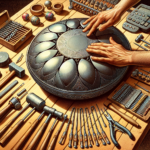The handpan, a relatively new musical instrument, has quickly become a favorite among musicians and hobbyists alike. Its ethereal sound and intuitive playability make it an excellent choice for both beginners and professionals. If you’ve decided to take the plunge and purchase your first Aura Handpan, congratulations! This guide will help you navigate the important considerations to make an informed decision.
Understanding the Aura Handpan
Before we delve into how to choose your first handpan, it’s essential to understand what an Aura Handpan is. Originating from the Hang, invented by Felix Rohner and Sabina Schärer in Switzerland, handpans are steel instruments with convex surfaces, tuned by carefully crafting note areas. These instruments have a cosmic, resonating sound that captivates anyone who hears it.
1. Selecting the Right Scale
The scale of the handpan is arguably the most crucial factor to consider. Handpans are typically diatonic and come in various scales that correspond to different moods and musical traditions.
- Major Scales: These are often described as upbeat and happy. Common major scales include the D Major and E Major.
- Minor Scales: Minor scales have a more introspective or melancholic sound. Common minor scales include the D Minor and C Minor.
- Exotic Scales: These scales, such as the Pygmy or Akebono, offer unique flavors from different cultural backgrounds.
Consider listening to various scales online or in person to see which resonates with you the most.
2. Quality of Construction
Quality craftsmanship is another essential factor. A well-made handpan will produce a clean, harmonious sound. Here are a few points to consider:
- Material: High-quality steel ensures durability and tonal richness.
- Tuning: Verify that the instrument is properly tuned. This may require consulting with an experienced player or retailer.
- Brand Reputation: Research various brands and read reviews. Established manufacturers often provide more reliable instruments.
3. Budget Considerations
Handpans can range dramatically in price, from a few hundred dollars to several thousand. While it might be tempting to go for the cheapest option, investing in a quality instrument will pay off in the long run.
- Entry-Level: Typically around $1,000 to $1,500. Perfect for beginners but ensure it doesn’t compromise on quality.
- Intermediate: Priced around $1,500 to $3,000. These are better crafted and offer more complex tonal ranges.
- Professional: Usually over $3,000. These handpans are from top-tier makers with impeccable sound quality and craftsmanship.
4. Number of Notes
The number of notes on a handpan can vary. Most handpans have between 7 to 9 notes. Here’s how to decide:
- Fewer Notes (7-8): Easier to start with, less overwhelming, and typically more affordable.
- More Notes (9+): Offers more musical flexibility but requires more skill to master.
5. Test Before You Buy
If possible, always test a handpan before purchasing. Here’s what to look out for:
- Sound Quality: Listen for any buzzing, rattling, or out-of-tune notes.
- Resonance: The sound should sustain and be clear.
- Comfort: Ensure the handpan feels comfortable to play.
If you can’t test the handpan in person, look for sellers who offer detailed sound samples or video demonstrations.
6. Consider After-Sales Support
A reputable seller should offer more than just the instrument. Consider:
- Warranty: Check if there is any warranty or guarantee.
- Customer Support: Responsive customer service can be invaluable, especially for beginners.
- Tuning Services: Handpans may need re-tuning over time; see if the seller offers this service.
7. Transport and Storage
Handpans are delicate instruments, and protection is crucial:
- Cases: Invest in a quality case for transportation.
- Storage: Store the handpan in a dry, cool place.
Conclusion
Choosing your first Aura Handpan is a highly personal journey that combines your musical preferences with practical considerations. By understanding the scales, ensuring quality craftsmanship, considering your budget, and testing the instrument, you can find a handpan that will bring joy and inspiration for years to come. Remember, the right handpan for someone else might not be the right one for you, so take your time to find your unique sound.
FAQs
- Q1: What is the easiest scale to start with?
- A1: Many beginners find that scales in D minor or C minor are easier to start with due to their intuitive layout and versatile sound.
- Q2: How often does a handpan need tuning?
- A2: Typically, a well-crafted handpan should hold its tuning for several years, but it can vary depending on how often and intensely it is played.
- Q3: Can I learn to play the handpan without any musical background?
- A3: Absolutely! The handpan is known for its ease of playability. Many beginners find it intuitive and rewarding even without prior musical experience.
- Q4: Are there any specific care instructions for a handpan?
- A4: Yes, keep the handpan in a dry, cool environment and regularly clean it with a soft cloth. Protect it from direct sunlight and avoid striking it with sharp or hard objects.
- Q5: Can I travel with my handpan?
- A5: Yes, but always use a high-quality protective case for transport. Many manufacturers offer travel-friendly cases designed to protect your instrument.





